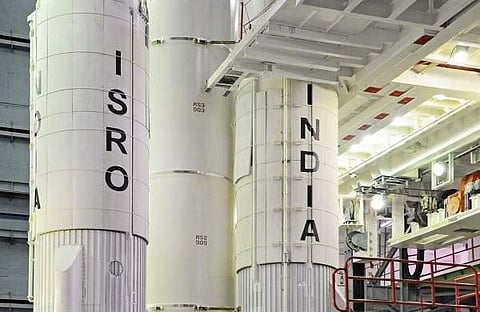

Following the monumental success of the Chandrayaan-3 lunar mission, the Indian Space Research Organisation (ISRO) is ramping up efforts to send Indian astronauts to the Moon by 2040, reports PTI.
ISRO Chief S Somanath revealed that four test pilots from the Indian Air Force have been designated as astronauts for the mission, the report states.
In an exclusive article for Manorama Yearbook 2024, Somanath said, “Looking ahead, ISRO aims to take the next step in space exploration with the Gaganyaan programme, planning to launch a crew of 2 to 3 Indian astronauts into Low Earth Orbit (LEO) for up to three days before safely returning them to a predefined site in Indian waters.”
The selected astronauts are currently undergoing mission-specific training at the Astronaut Training Facility (ATF) in Bengaluru, said Somanath, who is also Secretary, Department of Space, and Chairman of the Space Commission.
According to PTI, the Gaganyaan mission involves developing critical technologies, including a human-rated launch vehicle (HLVM3), an Orbital Module comprising a Crew Module (CM) and Service Module (SM), and life support systems.
Preceding the manned mission are two identical un-crewed missions (G1 & G2), Integrated Air Drop Test, Pad Abort Test, and Test Vehicle flights.
The Crew Module is designed for safe re-entry, and safety measures include a Crew Escape System (CES) for emergencies.
The first development flight of Test Vehicle (TV-D1) on October 21, 2023, successfully demonstrated in-flight abort of the Crew Escape System, Crew Module separation, and its safe recovery from the Bay of Bengal.
“The success of this test flight was crucial for subsequent unmanned missions and the ultimate human space mission, expected to be launched in 2025,” Somanath said.
Aditya L1, India's inaugural solar exploratory mission, is another significant project for ISRO, studying the Sun from the unique vantage point of Lagrange Point 1, he noted.
Launched on September 2, Aditya L1 is on its intended path towards Sun-Earth Lagrange Point 1 (L1), approximately 1.5 million km from Earth, and is set to enter a Halo orbit in January 2024, Somanath explained.
He also highlighted the Chandrayaan-3 mission's historic achievement, leading to the declaration of August 23 as National Space Day in India by Prime Minister Narendra Modi.
In its 14-day mission life, Chandrayaan-3 provided valuable lunar data, discovering various elements in lunar soil.
Somanath outlined other ongoing and upcoming missions, including the Small Satellite Launch Vehicle (SSLV), Reusable Launch Vehicle (RLV) program, X-ray astronomy mission XPOSAT, Space Docking Experiment, and LOX-Methane engine.
“Together, these transformative initiatives define a new space saga in India's pursuit of space exploration, fostering scientific progress and an ever-expanding cosmic horizon.” Elaborating, he said SSLV, a three-stage launch vehicle, can launch a 500 kg satellite into 500 km planar orbit, and can accommodate multiple satellites.
Somanath expressed confidence in India's space programme reaching new heights, citing ambitious goals set by the prime minister, such as commissioning the Bharatiya Antariksha Station (Indian Space Station) by 2035 and embarking on interplanetary exploration, including a Venus Orbiter Mission and a Mars Lander, to strengthen India's global space presence.
